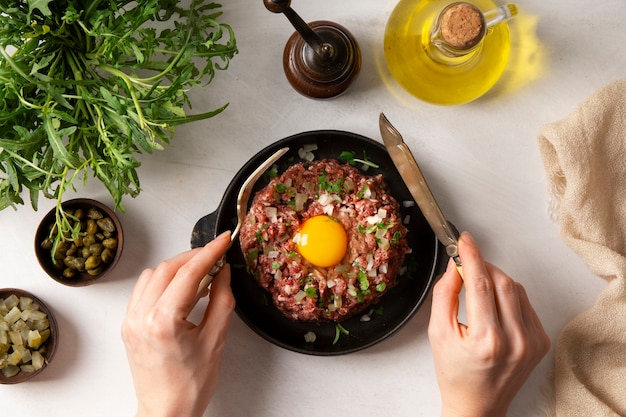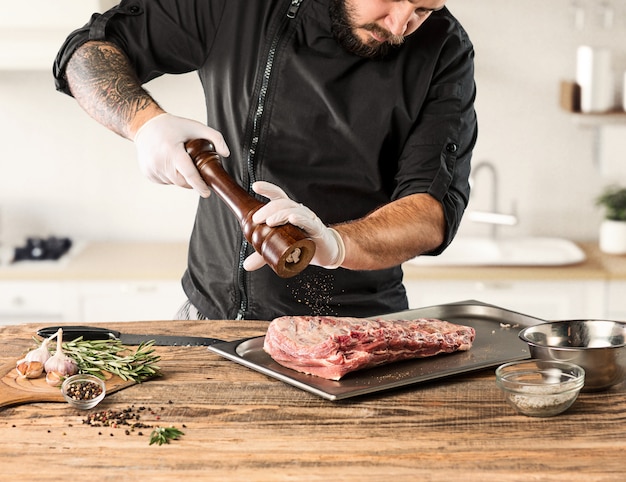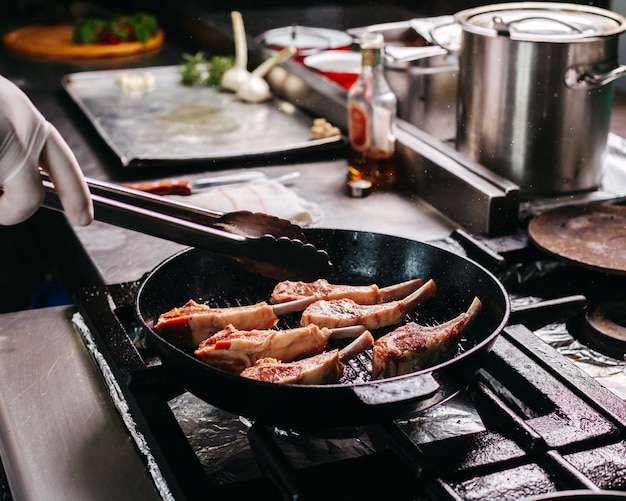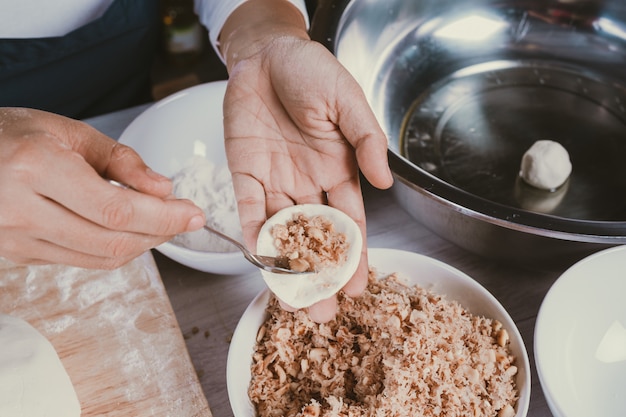Part 1: Setting the Stage: Selecting Your Steak

The Classics: The Steak Hall of Fame
- Rib-eye: Now, this is the ultimate indulgence. It's known for its rich marbling, which translates to a juicy, succulent texture and a flavor that's simply divine. Plus, it has a beautiful, wide surface area that's perfect for achieving that coveted crispy crust. It's like the rockstar of the steak world, always delivering an unforgettable performance.
- new york strip: A classic for a reason. This steak boasts a beautiful, long grain, resulting in a tender and flavorful cut that's a bit leaner than the rib-eye. If you're looking for a less fatty option without sacrificing flavor, the New York Strip is your go-to. It's like the reliable friend who always delivers.
- filet mignon: The most tender cut you can get, this is the epitome of luxurious steak dining. It's renowned for its delicate flavor and melt-in-your-mouth texture. It's also a fantastic choice for those who prefer a leaner steak. Think of it as the sophisticated, elegant option, perfect for special occasions.
Exploring Beyond the Basics: Finding Your New Favorite
- Sirloin: A versatile cut that strikes a beautiful balance between flavor and tenderness. It's a bit more budget-friendly than the classics but still delivers a fantastic steak experience. It's the dependable all-rounder, always up for the challenge.
- flank steak: This is a leaner cut, perfect for those who enjoy a more robust flavor. It's best cooked medium-rare to medium, as overcooking can make it tough. Think of it as the adventurous choice, full of personality and bold flavor.
Tips for Choosing the best steak: Spotting the Perfect Cut
- Look for Marbling: The more marbling (fat) a steak has, the more flavorful and tender it will be. Think of it like the butter in a cake, adding richness and moisture.
- Check the Color: A good steak should have a deep, rich red color, not a dull, purplish hue. It should almost glow with vibrancy.
- Feel for Texture: The steak should feel firm and springy to the touch, like a well-toned muscle. Avoid any steaks that feel soft or mushy, as they might not be as fresh.
- Go for Thickness: A thicker steak allows for more even cooking and prevents it from drying out, ensuring a consistently juicy and flavorful result. Think of it as a thicker layer of insulation for your steak.
Part 2: The Art of Preparation: Prepping Your Steak for Pan-Searing

Pat Dry, Pat Dry, Pat Dry: The Key to a Crispy Crust
This is absolutely crucial! If the surface of your steak is wet, it won't get that beautiful, crispy crust that we're aiming for. So, pat it dry with paper towels, making sure to remove any excess moisture. Think of it as a final touch-up for your steak, preparing it for its grand entrance.The Magic of Salt: Unlocking Flavor and Tenderness
Don't hold back on the salt! Seasoning your steak generously with salt is essential for flavor and texture development. Salt draws moisture out of the steak, creating a more flavorful surface and helping to tenderize the meat. It's like a magic touch that transforms your steak from ordinary to extraordinary.- Seasoning Time: I recommend seasoning your steak at least 30 minutes before you cook it, and up to 24 hours in advance. This allows the salt to penetrate the meat properly and work its magic.
- Salt Type: Kosher salt is my go-to for this, as it's coarser and dissolves more slowly, allowing for even seasoning and a more robust flavor. If you don't have kosher salt, fine-grain salt will work just fine.
The Flavor Explosion: Other Seasonings: Adding Depth and Complexity
Beyond salt, the world is your oyster when it comes to seasonings. While I'm a big fan of keeping it simple with just salt and pepper, here are some ideas to get your creative juices flowing:- Garlic Powder: Adds a savory, pungent flavor that complements the steak perfectly, creating a taste sensation that's both comforting and exciting.
- Onion Powder: Another fantastic option for adding depth of flavor, bringing a hint of sweetness and complexity to your steak.
- Paprika: Adds a touch of sweetness and a beautiful color to the steak, giving it a vibrant appearance and a hint of warmth.
- Herbs: Freshly chopped herbs like rosemary, thyme, or parsley can add a burst of freshness and aromatics, elevating your steak to new heights of flavor.
- Spice Blends: Experiment with ready-made spice blends like Cajun seasoning, Montreal steak seasoning, or even your own custom blends. Let your culinary creativity soar!
Let's Talk Temperature: Bringing the Steak to Room Temperature: The Secret to Even Cooking
This step isn't absolutely essential, but I always do it. Bringing your steak to room temperature before cooking ensures that it cooks evenly and prevents it from getting cold shock in the pan, which can make it tough. Think of it as a gentle warm-up for your steak, preparing it for the heat of the pan.- The Trick: Simply take your steak out of the refrigerator 30 minutes to an hour before you plan to cook it.
Part 3: The Big Reveal: Pan-Searing Your Steak to Perfection

The Pan Matters: Choosing the Right Tool for the Job: The Foundation of a Great Sear
- Cast Iron: My personal favorite for pan-searing. It distributes heat evenly and holds its temperature well, ensuring a beautiful sear that's both crispy and flavorful. It's a bit more work to maintain, but the results are truly worth it. Think of it as the seasoned veteran, always reliable and delivering exceptional results.
- Stainless Steel: A good alternative if you're not ready to commit to cast iron. Just make sure it's heavy-bottomed for even heat distribution. It's the dependable workhorse, always ready to get the job done.
- Non-Stick: Can work in a pinch, but it won't give you the same crispy sear as cast iron or stainless steel. Think of it as the backup plan, suitable for less demanding tasks.
Heat It Up: The Importance of High Heat: Creating the Perfect Crust
High heat is crucial for achieving that coveted crispy crust. You want your pan to be smoking hot before you add your steak, ready to sear it to perfection.- Test for Readiness: You can test if your pan is hot enough by placing a few drops of water on the surface. If the water sizzles and evaporates immediately, you're ready to go.
- Time: It'll take a few minutes for your pan to reach this temperature, so be patient. The wait will be well worth it.
The Art of Searing: Achieving a Beautiful Crust: Mastering the Technique
Alright, here's the key to a perfect pan-seared steak. This part requires a bit of attention and a steady hand, but it's worth the effort. It's like a culinary dance, a delicate balance of heat and timing.- Don't Crowd the Pan: Give your steak enough space to breathe. If you overcrowd the pan, the temperature will drop, and your steak won't get a nice sear.
- Don't Move It! Let the steak sit in the pan undisturbed for 3-4 minutes per side. This allows for a proper crust to form. Resist the urge to move it around too much.
- Flip It: Once you've achieved a nice crust on one side, carefully flip the steak over to sear the other side. Again, let it cook undisturbed for 3-4 minutes.
- The Sides: If you want to achieve a crust on the sides, you can use tongs to lift the steak and sear the edges. Be careful not to overcook the meat.
cooking time: How to Get Your Desired Doneness: Finding Your Sweet Spot
This is where things get a little more personal. The desired doneness of a steak varies from person to person, so finding your sweet spot is important. Do you prefer a rare steak with a cool red center or a well-done steak with no pink at all? It's your call!| Doneness | internal temperature (℉) | Internal Temperature (°C) | Appearance | Cooking Time (each side) |
|---|---|---|---|---|
| Rare | 125-130 | 52-54 | Cool red center | 2-3 minutes |
| Medium-rare | 130-135 | 54-57 | Pink center | 3-4 minutes |
| Medium | 140-145 | 60-63 | Slightly pink center | 4-5 minutes |
| Medium-well | 150-155 | 65-68 | Barely pink center | 5-6 minutes |
| Well-done | 160 | 71 | No pink center | 6 minutes |
The Finishing Touch: Resting Your Steak: Unlocking Tenderness and Flavor
Now, this step is super crucial! Resting your steak allows the juices to redistribute evenly throughout the meat, resulting in a more tender and flavorful cut. Think of it as a final moment of relaxation for your steak, allowing it to recover from the heat and enhance its flavor.- Time is Key: Rest your steak for 5-10 minutes before slicing and serving.
- The Setup: Place your steak on a cutting board and cover it loosely with aluminum foil to create a warm and humid environment for your steak to rest.
Part 4: Mastering the Sauce: Elevating Your Steak with Flavor
Alright, now for the finishing touches: the sauce! A good sauce can take your steak from good to spectacular, adding depth of flavor and making it truly unforgettable. While there are countless options out there, here are some of my favorites, the sauces that add a touch of magic to a perfect steak.The Classics: Simple and Delicious: Timeless flavor combinations
- Compound Butter: This is my go-to for adding a touch of richness and flavor. Simply melt butter with herbs like rosemary, thyme, or garlic, and pour it over your steak as it rests. It's like a warm hug for your steak, enveloping it in flavor and aroma.
- Red Wine Sauce: A timeless classic for steak. Deglaze your pan with red wine, adding shallots, garlic, and herbs for an irresistible sauce. It's like a symphony of flavors, each ingredient playing its part to create a harmonious and delicious experience.
Get Creative: Explore Beyond the Basics: Embracing New Flavors and Combinations
- Béarnaise Sauce: This classic French sauce is a bit more involved but delivers a luxurious flavor. It's made with clarified butter, egg yolks, vinegar, and herbs. It's like a culinary masterpiece, a testament to the artistry of french cuisine.
- Blue Cheese Sauce: For those who love a bit of pungent flavor, blue cheese sauce is a fantastic option. Simply melt blue cheese with cream and add a touch of lemon juice. It's a bold and daring choice, for those who appreciate a strong flavor profile.
- Peppercorn Sauce: A simple but effective sauce made with black peppercorns, butter, and cream. It adds a touch of heat and complexity, making your steak even more irresistible.
The Finishing Touches: Serving Your Steak with Style: A Presentation That Makes a Statement
Now that your steak is perfectly cooked and resting, it's time to present it with a bit of flair. It's the final step in the culinary journey, where you elevate your steak from a meal to an experience.- Slice It: Slice your steak against the grain to make it easier to chew and showcase the beautiful marbling. This is like revealing the hidden beauty of your steak, showcasing its intricate patterns and textures.
- The Presentation: Place your steak on a plate with your chosen sauce, a side of roasted vegetables, mashed potatoes, or a simple salad. It's about creating a visual feast that complements the flavors of your steak.
- Don't Overdo It: Keep it simple and let the flavor of the steak shine. Let the steak be the star of the show, the hero of your culinary creation.
Part 5: FAQs: Your Steak-Related Questions Answered: The Ultimate Steak ResourceSo, you've got questions. We've all been there. It's a good thing! It shows you're passionate about achieving that perfect steak. Here are some common questions and my advice, your ultimate guide to navigating the world of steak.
1. How Do I Know When My Steak Is Done?
There are a few ways to check for doneness, each offering a different level of precision. The most accurate method is to use a meat thermometer, but you can also use the touch test or the color of the meat as a guide.- Meat Thermometer: Insert the thermometer into the thickest part of the steak. Refer to the table above for the internal temperature corresponding to your desired doneness. It's the most reliable method, ensuring that your steak is cooked to your exact specifications.
- Touch Test: This method is less precise but can be helpful. Press the center of the steak. If it feels firm, it's well-done. If it feels slightly springy, it's medium. And if it feels soft, it's rare. It's a good option for those who prefer a more intuitive approach.
- Color: If you're not sure about the touch test, you can also use the color of the meat as a guide. A rare steak will have a cool red center, while a medium-rare steak will have a pink center. A medium steak will have a slightly pink center, and a well-done steak will have no pink at all. It's a visual cue that can help you gauge the doneness of your steak.
2. What If I Overcook My Steak?
Don't panic! If you've overcooked your steak, it's not the end of the world. It might be a bit tougher than you'd like, but it can still be delicious. You can try to salvage it by adding a flavorful sauce or serving it with a soft side dish like mashed potatoes or rice to counteract the dryness. Remember, even a slightly overcooked steak can still be salvaged with a little culinary creativity.3. Can I Marinate My Steak?
Yes, you can definitely marinate your steak! Marinating can add a lot of flavor and tenderize the meat. Just make sure to use a marinade that's not too acidic, as it can make the steak tough.- Marinating Time: Marinate your steak for at least 30 minutes, but no longer than 24 hours. Longer marinating times can cause the meat to become too salty or mushy.
4. How Do I Store Steak in the Refrigerator?
Proper storage is essential to maintaining the quality of your steak.- The Wrap: Wrap your steak tightly in plastic wrap or place it in a freezer-safe bag.
- The Temperature: Store it in the coldest part of your refrigerator, ideally at 37°F (3°C) or below.
- Shelf Life: Steak will last for 3-5 days in the refrigerator.
5. What Are Some Good side dishes for Steak?
The possibilities are endless! Here are a few classic pairings that always go well with steak, adding a touch of balance and harmony to your culinary creation.- Roasted Vegetables: Add some color and texture to your plate with roasted vegetables like asparagus, broccoli, or Brussels sprouts. They provide a vibrant contrast to the richness of the steak.
- Mashed Potatoes: Creamy and comforting, mashed potatoes are a perfect pairing for steak. They provide a soft and velvety counterpoint to the firmness of the steak.
- Garlic Bread: A simple but satisfying side dish that complements the steak nicely. It adds a touch of warmth and comfort to your meal.
- Salad: Add a touch of freshness and lightness with a simple salad. It provides a refreshing contrast to the richness of the steak.
- Mac and Cheese: A decadent and cheesy side dish that always goes down well. It's a classic pairing that adds a touch of indulgence to your meal.
Part 6: The Final Word: The Journey to Steak Perfection
So there you have it! My comprehensive guide to pan-searing steak to perfection. Remember, it's all about the details, from choosing the right cut to mastering the art of searing and resting. But most importantly, it's about having fun and embracing the journey. Experiment, explore different flavors, and discover what works best for you. With a little practice, you'll be turning out restaurant-quality steaks in your own kitchen. And let's be honest, what could be better than that? Now, go forth and conquer the world of steak! You've got this.Everyone is watching

How to Cook Frozen Lobster Tails Perfectly: A Step-by-Step Guide
RecipesLobster. Just the word conjures up images of lavish meals, special occasions, and a taste of luxury. But let's...

Pigs in a Blanket Cooking Time: How Long to Bake for Perfect Results
RecipesAh, pigs in a blanket. Just the name conjures up images of those delightful little parcels of crispy pastry en...

Pork Fillet Cooking Time: How Long to Cook It Perfectly
RecipesPork fillet, or tenderloin as it's sometimes called, is a real favourite in our house. It's so versatile, and...

The Ultimate Guide to Tender, Juicy Pulled Pork
RecipesRight, let's talk pulled pork. It's one of those dishes that just screams "comfort food," doesn't it? I mean...

The Ultimate Guide to Cooking Delicious Frankfurters
RecipesLet's face it, we all love a good frankfurter. It's a classic, simple, and always satisfying. But let's be rea...
